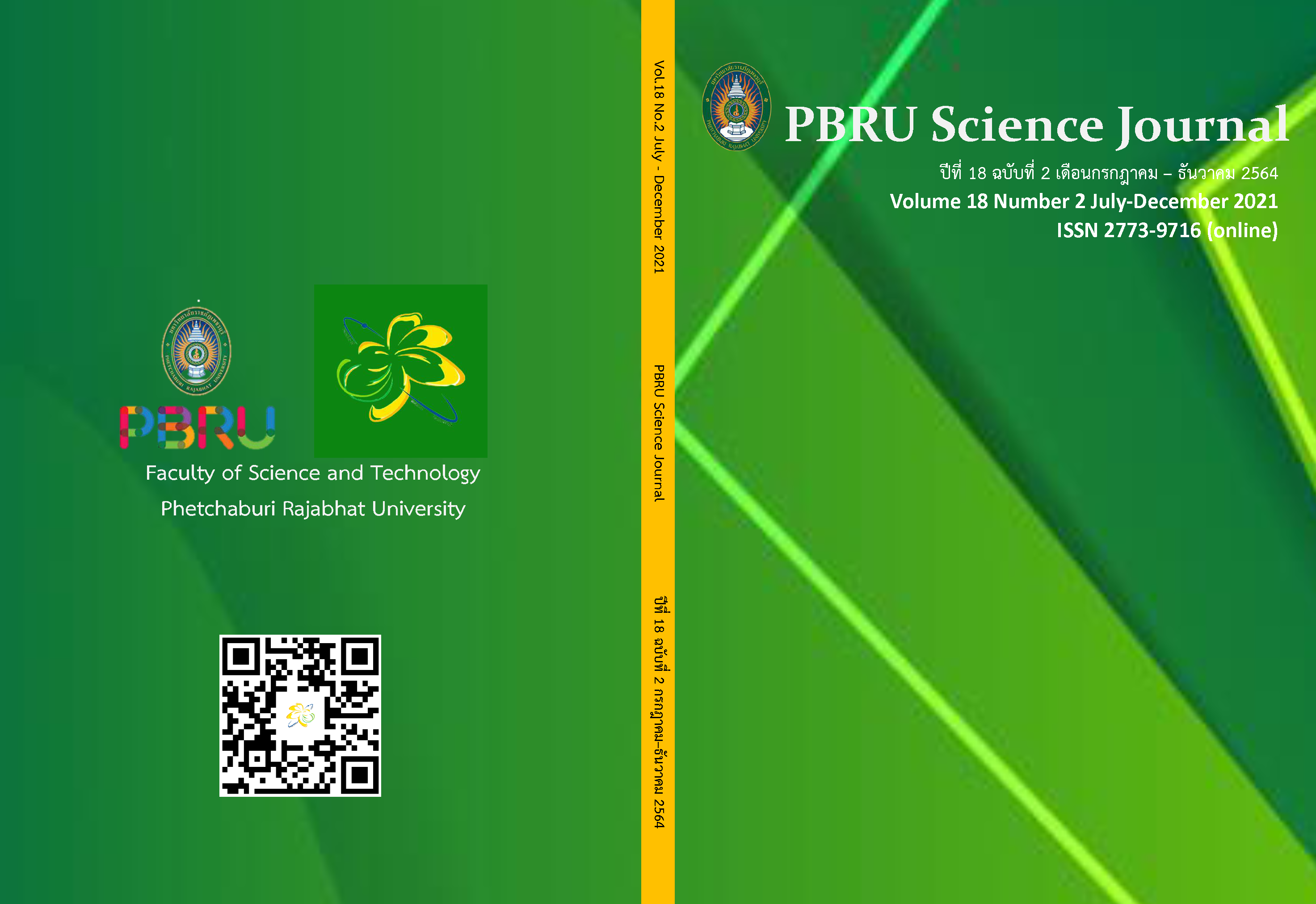การตรวจสอบระบบแก้ว Bi–Pb โบโรซิลิเกตสำหรับการกำบังรังสี
Main Article Content
บทคัดย่อ
งานวิจัยนี้ได้ศึกษาค่าพารามิเตอร์สำหรับการใช้งานของระบบแก้วกำบังรังสี ในระบบ xBi2O3–(50 – x) PbO–20B2O3–30SiO2 โดย x = 2, 4, 6, 8, and 10 mol.% ซึ่งค่าต่าง ๆ ได้แก่ ค่าสัมประสิทธิ์การลดทอนเชิงมวล เลขอะตอมยังผล ความหนาครึ่งค่า และค่าระยะทางอิสระเฉลี่ย โดยใช้ Phy-X/PSD ซอฟต์แวร์ ที่ช่วงพลังงาน 10–3 ถึง 105 MeV ผลการศึกษา พบว่า ค่าสัมประสิทธิ์การลดทอนเชิงมวลของระบบแก้วตัวอย่างนี้มีค่าเพิ่มขึ้นตามปริมาณของ Bi2O3 ที่เพิ่มขึ้น และลดลงตามระดับพลังงานที่เพิ่มขึ้น ซึ่งสามารถแบ่งลักษณะออกเป็น 3 ช่วงพลังงาน คือ อันตรกิริยาดูดกลืนโฟโตอิเล็กทริก การกระเจิงของคอมป์ตัน และการผลิตอันตรกิริยาคู่ ซึ่งเป็นอันตรกิริยาหลักที่เกิดในช่วงพลังงานระดับต่ำ กลาง และสูง ตามลำดับ และพบว่า ระบบแก้ว 10Bi2O3–40PbO–20B2O3–30SiO2 มีค่าสัมประสิทธิ์การลดทอนเชิงมวล และเลขอะตอมยังผลสูงสุด ในขณะที่ความหนาครึ่งค่า และระยะทางอิสระเฉลี่ยมีค่าต่ำสุด ซึ่งแสดงให้เห็นว่าแก้วตัวอย่างนี้มีความสามารถในการกำบังรังสีได้ที่สุด จึงแสดงให้เห็นว่าตัวอย่างแก้วนี้สามารถนำไปประยุกต์ใช้เป็นวัสดุกำบังรังสีได้ดีที่สุด
Article Details

อนุญาตภายใต้เงื่อนไข Creative Commons Attribution-NonCommercial-NoDerivatives 4.0 International License.
บทความที่ได้รับการตีพิมพ์เป็นลิขสิทธิ์ของ PBRU Science Journal
เอกสารอ้างอิง
Almohiy H, Saad M, Shaaban ER, Abou Deif YM, Reben M, Yousef E. Raman structural and gamma radiation shielding features for amorphous matrials TLBLa(Nb/Ti)Chalcogenide Letters 2020;17(8):397–403.
Kaewjaeng S, Kothan S, Chaiphaksa W, Chanthima N, Rajaramakrishna R, Kim H, Kaewkhao J. High transparency La2O3-CaO-B2O3-SiO2 glass for diagnosis x-rays shielding material application. Radiat. Phys Chem 2019;160:41–7.
Alharbi T, Mohamed HF, Saddeek YB, El-Haseib AY, Shaaban KS. Study of the TiO2 effect on the heavy metals oxides borosilicate glasses structure using gamma-ray spectroscopy and positron annihilation technique. Radiat. Phys Chem 2019;164:108345.
Takai ZI, Kaundal RS, Mustafa MK, Asman S, Idris A, Shehu Y, Mohammad J, Idris MG, Said M. Gamma Ray and FTIR Studies in Zinc Doped Lead Borate Glasses for Radiation Shielding Application. Mater Res 2018;22(1):1–4.
Kaky KM, Sayyed M, Laariedh F, Abdalsalam AH, Tekin H, Baki S. Stuctural, optical and radiation shielding properties of zinc boro-tellurite alumina glasses. Appl Phys A 2019;125(1):32.
Sayyed M, Askin A, Ali AM, Kumar A, Rashad M, Alshehri AM, Singh M. Extensive study of newly developed highly dense transparent PbO-WO3-BaO-Na2O-B2O3 glasses for radiation shielding applications. J Non-Crystal Solids 2019;521:119521.
Kaur P, Singh K, Kurudirek M, Thakur S. Study of environment friendly bismuth incorporated lithium borate glass system for structural, gamma-ray and fast neutron shielding properties. Spectrochim Acta Part A Mol Biomol Spectroscopy 2019;117309.
Gerward L, Guilbert N, Bjorn Jensen K, Levring H. X-ray absorption in matter. Reengineering XCOM. Radiat Phys Chem 2001;60:23–4.
Gerward L, Guilbert N, Jensen KB. Levring H. WinXCom - a program for calculating X-ray attenuation coefficients. Radiat Phys Chem 2004;71:653–4.
Berger MJ, Hubbell JH. 1987/1999. XCOM: photon cross sections database, Web Version 1.2, available at http://physics.nist.gov/xcom. National Institute of Standards and Technology, Gaithersburg, MD 20899, USA. (Originally published as NBSIR 87-3597 “XCOM: Photon Cross Sections on a Personal Computer”).
Nowotny R. XMuDat: Photon attenuation data on PC. IAEA-NDS-195 International Atomic Energy Agency. Vienna, Austria; 1998.
Okunade A. Parameters and computer software for the evaluation of mass attenuation and mass energy absorption coefficients for body tissues and substitutes. J Med Phys 2007;32:124–32.
Taylor ML, Smith RL, Dossing F, Franich RD. Robust calculation of effective atomic numbers: the Auto-Z(eff) software. Med Phys 2012;39:1769–78.
Un A, Caner T. The Direct- Z(eff) software for direct calculation of mass attenuation coefficient, effective atomic number and effective electron number. Ann Nucl Energy 2014;65:158–65.
Yalcin Z, Icelli O, Okutan M, Boncukcuoglu R, Artun O, Orak S. A different perspective to the effective atomic number (Z(eff)) for some boron compounds and trommel sieve waste (TSW) with a new computer program ZXCOM. Nucl Instrum Methods A 2012;686:43–7.
Eyecioğlu Ö, El-Khayatt A, Karabul Y, Çağlar M, Toker O, İçelli O. BXCOM: a software for computation of radiation sensing. Radiat Eff Defects Solids 2019;174:506–18.
Erdem Şakar, Özgür Fırat Özpolat, Bünyamin Alım, Sayyed MI, Murat Kurudirek. Phy-X / PSD: Development of a user friendly online software for calculation of parameters relevant to radiation shielding and dosimetry. Radiation Physics and Chemistry 2020;166:1–12.
El–Sayed A. Waly, Mohamed A. Bourham. Comparative study of different concrete composition as gamma–ray shielding materials. Annals of Nuclear Energy 2015;85:306–10.
Abdel-Latif AM, Sayyed MI, Tekin HO, Kassab MM. Optimizing the shielding properties of strength-enhanced concrete containing marble. Papers in Physics 2020;12,120005.

